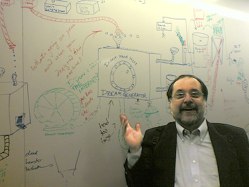
I’m at ISTE, and haven’t had time to do anything but listen, talk, do a little eating and sleep. No time to write or even think. I am just wow’ed by the ideas from EduBloggerCon, the opening keynote and some of the outstanding session presentations I’ve — and there are such powerful presenters here. I was especially impressed by Heidi Hayes Jacobs. She has contributed so much through her writings — but folks who write influentially often are not very good presenters. This is certainly not true for Jacobs, and I hope to write a blog post about here presentation.
At this moment, I want to mention a couple of things about the opening keynote speaker. John Medina, author of Brain Rules, is a biological engineer. Again, I wasn’t expecting much, and was especially frustrated by the cramped conditions of where I was sitting and the Amazonian woman I was sitting behind, blocking out most of the light of day. I’ve become so spoiled by stadium seating in movie theaters.
But right away, I knew that my time with Dr. medina was going to go fast. He had a sense, wasn’t taking himself too seriously, and he also was not going to pull any punches. On several occasions, I turned to the person sitting next to me and mouthed, “WOW!”
Perhaps the most impactful statement was when he described what we know about the human brain. He said that, “The human brain is designed to solve problems related to surviving in an unstable outdoor environment and to do so in nearly constant motion.”
Then he said something to the effect of, “If you wanted to design a learning environment that was directly opposed to the way that the brain works, you would design a classroom.”
“WOW!”


Hi David,
If you haven’t had a chance to read Dr. Medina’s book “Brain RUles” it is an easy, enjoyable, and eye-opening read. Wow is word that will pop into your mind quite often. I had the priviledge of hearing him speak at our school last summer. I was impressed by his desire to increase collaboration between schools and brain researchers, but I wonder how to even get something like that started.
I was equally impressed with Dr. Medina’s speech. I liked that he pulled no punches. We can only hope that technology usage enables us to reach the disenchanted with education and pull them back into their own potential, within or without the 4 walls of a classroom.
This is amazing and I am very sorry I missed the whole presentation. It is funny to me because when kids enter a preschool or even day care program, it is all designed around movement. That is – all the songs have dances, all the colors and days of the week and just about anything else kids are asked to do is set to motion – the reasoning is that it helps them retain the information – not so fast forward and you get a stagnate classroom where students are punished for being out of their seat. ??? Where is the logic? I agree, there has to be something more, some sort of bridge or at least recognition that kids and classrooms will and do function better if there is some kinetic energy.
As a former early childhood teacher, I can affirm that movement is key to teaching young children. I am hoping that I can find ways to incorporate it into my 8th grade classroom this year. I do notice that around 4th/5th grade, boys especially do not want to participate in organized motor activities that appear too much like “dancing”. But they do like to play games that involve throwing a ball or moving around the room (four corners). I think teachers of older students are so focused on “getting through” the content, they forget that the learners should be the focus of the classroom.